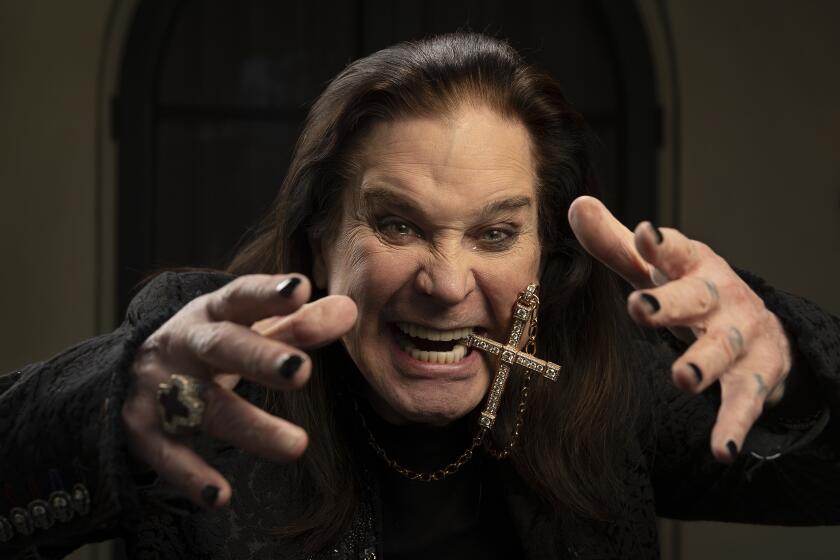Get Ready to Boop Till You Droop
- Share via
Animation is about lines that move, and they have never moved with as much invention, imagination and just plain fun as they did when they came from the Fleischer Studios.
Beginning in the silent era and staying afloat a bit more than 20 years until the studio closed in 1942, brothers Max and Dave Fleischer and their brand of hilarious and surreal irreverence gave the gang at Disney some serious competition. Creators of Ko-Ko the Clown and Betty Boop, popularizers of Popeye and Superman, the Fleischers were wild and crazy guys whose best work remains as outright entertaining today as ever.
Starting Friday and running for consecutive Friday and Saturday nights through Jan. 25, the Los Angeles County Museum of Art is offering a six-evening retrospective entitled “Out of the Inkwell: Betty Boop, Popeye, and Much, Much More From the Fleischer Studios.” Max’s son, director Richard Fleischer, will introduce the event on Friday, and Myron Waldman, the last surviving Fleischer animator, will be present Jan. 17. Utilizing rarities and archive restorations, this series underlines that inventiveness is not a matter of modern technology but a glorious state of mind.
The “Out of the Inkwell” title refers to the way one of the studio’s original characters,Ko-Ko the Clown, appeared on the screen climbing out of an ink bottle. Ko-Ko’s smooth movements came from an invention Max Fleischer patented, the rotoscope, which allowed animation to duplicate human movement. Max himself regularly appeared as Ko-Ko’s flesh-and-blood foil, and their battles were memorable. (These will be screened on Friday and Jan. 24 with live piano accompaniment by Robert Israel).
The Fleischers’ best-known creation is, of course, Betty Boop, still so popular that 115 original cartoons, more than 13 hours’ worth, are available in a video collection that comes with a printed “Boopliography.” With her bee-stung lips and itsy-bitsy voice (courtesy of Mae Questal), Betty’s innocent but pronounced sexuality made this one area where the straight-arrow Disney organization wouldn’t dare to follow.
True to the Fleischers’ boast that “made of pen and ink, she can woo you with a wink,” Betty dances such a mean hula in “Betty Boop’s Bamboo Isle” she makes the flowers blush. Betty eventually turned into a demure matron, but in films like 1932’s “Boop-Oop-A-Doop” her abbreviated costumes drew all kinds of attention. A lascivious ringmaster has evil on his mind in that situation, but our heroine assures the audience at the close, “he couldn’t take my boop-oop-a-doop away.”
The Fleischers didn’t invent Popeye, but when presented with him, Max felt “this is a nutty little creature, but I think I could do something with it.” That something included a pair of two-reel Technicolor featurettes (screening Jan. 18) that helped make the sailor man more popular for a time than Mickey Mouse.
Improbably described by Italian animation authority Giannalberto Bendazzi as “an angular, grouchy, selfish character,” Popeye is at his best in one of those featurettes, “Popeye the Sailor Meets Ali Baba’s Forty Thieves.” He barks “open sez me” at the appropriate moments and gloats when it’s all over, “I may be a shorty but I licked the forty.” Too bad Sylvester Stallone and Jean-Claude Van Damme don’t have writers like that.
Despite its short life span, Fleischer Studios had numerous ups and downs, including a ruinous strike by animation workers who, according to Charles Solomon’s comprehensive “Enchanted Drawings: A History of Animation,” chanted, “We’re Popeye the union man.”
Cartoon versions of “Superman” were a success; attempts at features such as “Gulliver’s Travels” and an early version of “Microcosmos” called “Mr. Bug Goes to Town” less so. Finally, however, the Fleischers and their anarchic, anything-goes ethos proved to be no match for the organization men at Disney and their emphasis on duplicating reality.
The Fleischers also had a penchant for films (featured in a Jan. 18 program called “Educationals and Oddballs”) that can honestly be described as eccentric. “The Einstein Theory of Relativity” is an attempt to let the public in on the great man’s work. And in “Finding His Voice,” a piece of silent film named Mutey is helped by his friend Soundie to join the talking picture age. Really.
As entertaining as ever today, the Fleischer output is characterized by a pair of aces. One was its inventive use of the best of contemporary sound, often having acts from Cab Calloway and Lillian Roth to the Royal Hawaiians photographed live as well as used as background music.
And when Calloway saw what the studio had done with his music in “Minnie the Moocher” (screening Jan. 11), Dave Fleischer claimed, he “laughed so much that he fell right down on the floor of the projection room and kicked his feet in the air.”
Finally, however, it all comes down to the glorious unpredictability of those Fleischer Studios lines. Believing that anything that can be drawn can be made to move, these cartoons feature applauding mustaches, a knife blade becoming a shark, even flames dancing a hoedown. With the Fleischers, you can’t begin to imagine what will happen next, and what better recommendation could cartoons have than that?
*
* “Out of the Inkwell,” L.A. County Museum of Art’s Bing Theater, 5905 Wilshire Blvd. Friday: “A Fleischer Potpourri,” “Cuckoo for Ko-Ko”; Saturday: “Betty Boop’s Rise to Fame,” “Jazz and Musical Cartoons”; Jan. 17: “Myron Waldman, Animator,” “Scary Stuff”; Jan. 18: “Strong to the Finich,” “Educationals and Oddballs”; Jan. 24: “Further Adventures of Max and Ko-Ko,” “Gulliver’s Travels”; Jan. 25: “Mr. Bug Goes to Town,” “Closing Night Rarities.” All programs, 7:30 p.m., $4-$6. Also, animation matinees on Jan. 18 and 25, 3 p.m., $2. (213) 857-6010, (213) 480-3232.
More to Read
The biggest entertainment stories
Get our big stories about Hollywood, film, television, music, arts, culture and more right in your inbox as soon as they publish.
You may occasionally receive promotional content from the Los Angeles Times.











